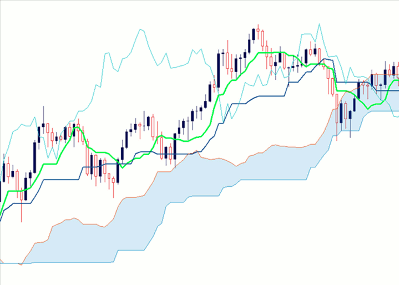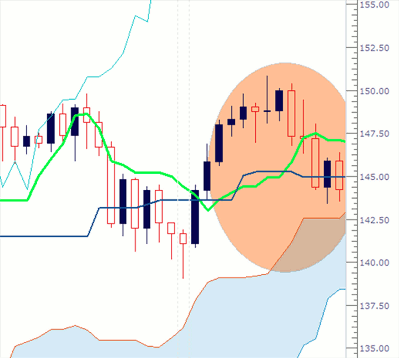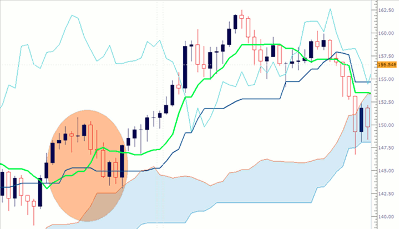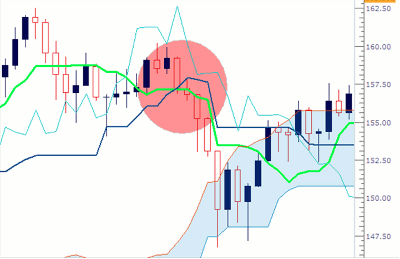Ichimoku analysis is a powerful technical method that is gaining popularity and worldwide acceptance. Learn the basics here and you’ll be on your way to making more confident trading decisions.
Read Part 2 and Part 3 of this three-part article series.
A type of technical analysis that has recently gained popularity in the United States is Ichimoku (pronounced “Each-E-Mo-Ku”). Like many technical analysis tools and indicators, it has the potential to be a self-fulfilling prophecy the more traders watch and make decisions with it.
The term Ichimoku literally means “one glance” in Japanese. Ichimoku is considered to be a self-contained system in the fact that no additional indicators are necessary; everything is included that most traders will need to make confident trading decisions. So how can we use it in our own trading?
Ichimoku is a trading system that was originally developed by Japanese journalist Goichi Hosada as he was looking to develop the ultimate indicator that could provide a multitude of analysis with a very quick glance.
Ichimoku is widely traded and followed throughout Japanese trading rooms, making it a particularly good indicator system for trading yen pairs such as GBP/JPY, EUR/JPY, and USD/JPY.
There are quite a few components of Ichimoku, and it can make a chart look quite busy. In this article, we are going to walk through the core elements of Ichimoku and how traders are using those parts of the indicator to analyze markets.
Trigger the Base Line
At the very core of Ichimoku are the “Tenkan-Sen” and “Kijun-Sen” lines (referred to from here on out as Tenkan and Kijun, respectively.) These two lines are the center of the Ichimoku system and can be looked at as the “trigger” that denotes bullishness or bearishness.
Tenkan and Kijun are really just moving averages. They differ slightly from standard moving averages in that they consider the “average” price of each candle versus only the closing price (like a simple or exponential moving average generally will). This causes the line to appear jagged (as opposed to the smoothing effect of a moving average calculated on the close).
Tenkan is commonly the first input that the trader will see when applying Ichimoku to a chart. This is a nine-period moving average, and we can consider this the “trigger line” of the system, as this is where all of the action behind Ichimoku is taking place. I make this line lime green when applying Ichimoku so that it stands out and it’s very clear when a crossover takes place.
Kijun is commonly the second input that is used, and this is a 26-period moving average (also exponential, calculated on average price). We can consider this as the base line. When the trigger line crosses up and over the base line, this can be considered a bullish signal. When the trigger crosses down and goes through the base line, this can be looked at as a bearish signal.
The rest of the indicators within Ichimoku tell us the strength with which the signal can be interpreted.
NEXT: Learn to Identify the Trigger/Base Line Crossover
|pagebreak|
For right now, it is important to become familiar with the trigger/base line crossover. If you’re not comfortable with this crossover yet, let’s apply it on the chart and manually backtest a few trades to get comfortable with the way that this works.
While learning the trigger/base line crossover, it may help to arrange the Ichimoku indicator in an easy-to-read manner so that crossover is very clearly printed on the chart. For the remainder of this article, I will be using a green line for Tenkan and a blue line for Kijun.
Once completed, our charts should look roughly similar to what you see below:
Now that we have Ichimoku completely applied to our charts, we can look at the power that the trigger line/base line crossover has.
For right now, let’s ignore everything on the chart other than the trigger and the base lines.
Backtesting is a great way to gain confidence in any technical indicator, including Ichimoku. Check with your trading platform provider about how to do this on your specific platform.
For example, notice on the below chart that we have a bullish crossover taking place on the GBP/JPY pair. I’ve highlighted the portion of the chart in which the trigger line is crossing over the base line, indicating the bullishness that may be entering into the pair.
NEXT: See the Price Action That Happened Next
|pagebreak|
And looking forward, here is what happened next:
After testing the way that this buy entry would have worked, we see that the bullish crossover of the trigger line over the base line immediately preceded a 1,000-plus-pip run on the GBP/JPY currency pair.
We can then move on to the next crossover, and if you look at the chart above, you’ll notice that the bearish crossover (where the trigger line fell down and through the base line) took place shortly after the high around 162.50 was hit. We can now chart this sell entry to see the way that it would have hypothetically worked out for us.
In the chart below, I’ve highlighted this sell entry, as the trigger line has crossed down and through the base line. Notice that this entry would not have been as profitable as the previous bullish entry that we had taken, but after the signal took place, GBP/JPY went down over 700 pips.
The goal of manually backtesting these entries is so that we can internalize what happens when the trigger line crosses the base line.
These are two of the most important elements of Ichimoku and are the very core of the system. Everything else in Ichimoku helps us interpret these buy and sell signals, indicating how strong they may have been.
In future articles, we will discuss these elements and how they can help us interpret the trigger line/base line crossover.
Manually backtest until you feel comfortable with the trigger line/base line crossover, and comfort with this signal is of the upmost importance when trading Ichimoku.
If you have a difficult time remembering which line is which, try to think of it as “Tenkan = Trigger and Base Line = Blue.”
Read Part 2 and Part 3 of this three-part article series.
By James Stanley of DailyFX.com
DailyFX provides forex news on the economic reports and political events that influence the currency market.























